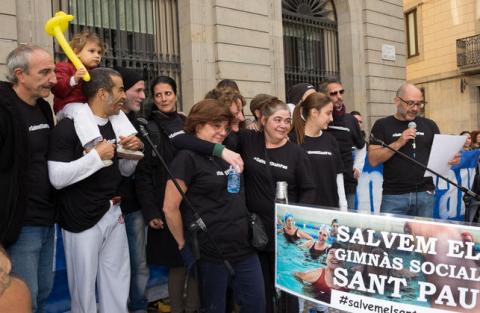We reproduce, humbly translated into English, the interesting article by Pedro Bravo, originally published in ElDiario.es
"There is a place in Barcelona where a large part of urban conflicts seem to come together, a place that could serve as an example to show what goes wrong in our cities. The place is also a meeting point for many of the solutions for these conflicts, a space not only physical in which a handful of people and ideas have coincided that propose changing the future of that place and of the city itself. In the district of Ciutat Vella, punished for so many things, where the neighborhoods of Raval, Sant Antoni and Poble Sec are located, there is a unique property where great things happen.
The Sant Pau gym calls itself social and does very well. With almost 80 years of history, it is now managed by a workers' cooperative that not only gives service as a space for the practice of various sports at popular prices, but also offers free access to people from vulnerable groups and showers for the homeless. As well as access to teenagers in exchange for doing well in school, open the pool once a week so that Muslim women can swim and keep special schedules in Ramadan, has changing rooms and classes for trans people, allows registration to people without papers and, in general, it is open for all those who usually close their doors.
All this happens every day on 1 floor - the ground and street floor - which is a candy for real estate capital. In this area ravaged by gentrification and the replacement of neighbors by tourists, the Sant Pau is the promise of a major business for the property, the Samaranch-Viñas family (unrelated, apparently, with the Olympic).
For this reason, the workers of the gym have been fighting against expulsion attempts for years and promoting the union of neighbors, groups and professionals through a mobilization and a proposal whose proposals and objectives go far beyond the survival of the business itself and have to do with the activation of true participatory democracy processes in the neighborhoods, with an innovative model of housing with a social purpose and with a city that knows how to defend and save spaces and projects like this is a way to save itself.
The problem is that, in the few remaining weeks of the year, the gym and the project to build social housing on it: the property has sued again to achieve eviction and the City of Barcelona does not finish executing the decisions to which it had committed.
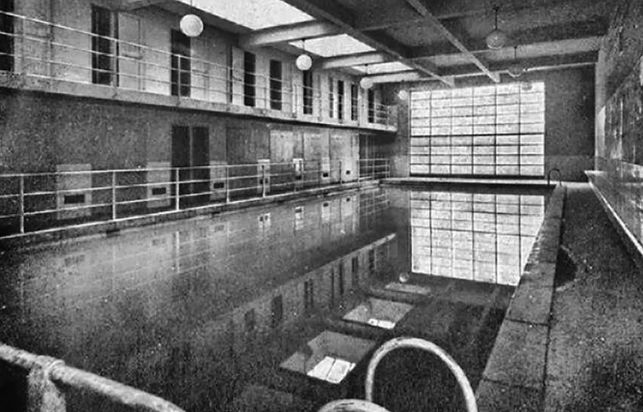
The history. At the place where Sant Pau is located, social action comes from birth. In 1940, on this 46th of the Ronda de Sant Pau, the General Society Aguas de Barcelona opened its Popular Baths "to make a set of hygienic services available to the less well-off population". In those times of postwar, poverty and housing without water or services, baths, showers and swimming pool were offered at reasonable prices. This was until 1960, when the Catalan Swimming Federation took over and was converted into a gymnasium and the first chlorinated pool in the city, where a good part of the residents of Ciutat Vella learned to swim. After a period of management by the Escoles Pies, in 1992 the gym acquired a group of professors from INEF. After years of good performance and profitability, they began to accumulate debts and defaults, apparently for bad investments. Faced with the threat of closure, a group of workers of the company took over the business for one euro and assumed debts. That was in 2012.
At that time, the Samaranch-Viñas had already been a few decades owners of that place and more land in the vicinity. In 2007 they already tried to sell it to make a hotel, but the idea, along with a few thousand euros of initial investment, flew with the crisis. In any case, they were very clear that the business and the profitability they wanted was not in renting the premises to a social gym.
The gym. The social here is not a pose, it is in the attitude of each one of the workers and even of the people who visit and support the gym. I could see it during my visit there, with an autumn downpour finally turning Barcelona into Venice and a constant bustle of diverse clients: kids coming out of school, old people from the neighborhood, immigrants and even tourists who asked the price to stay in shape while it lasted their visit. That day, at the time of closing, two sub-Saharan Africans were sitting at the tables at the entrance learning Spanish with a mobile application. One of them, wearing plastic flip-flops, ended up walking on the flooded streets with slippers that Ernest Morera, a former director and partner of the center, insisted on giving him.
According to what he told me while he was showing me the space, the social goal was set by him and the rest of the workers who took over the business in 2012. By personal trajectories and convictions, but also because, having to face the debts and the pressure, they decided that, since they been a part of it, that it was for a project that filled them with hope. And, thus, listening to the needs of those neighborhoods where the brilliance of success cannot cover inequality and exclusion, were making Sant Pau an essential tool for social assistance in Barcelona.
Today, the Sant Pau, with 500 members, offers other sports activities to 900 people linked to more than thirty entities (especially welcoming children, refugees and other vulnerable groups), maintains a shower service for homeless people (about 1,100 a month) , allows access to people without papers, listens to the special needs of all kinds of people and does everything in exchange for not receiving a euro from either the administrations or third sector organizations. The Sant Pau, which is a modest neighborhood gym, good size and with decent facilities but not updated at all, has been working as a shelter for years and has done so by putting the time and money of its working partners and, also, in silence, without showing off, because it had to be done.
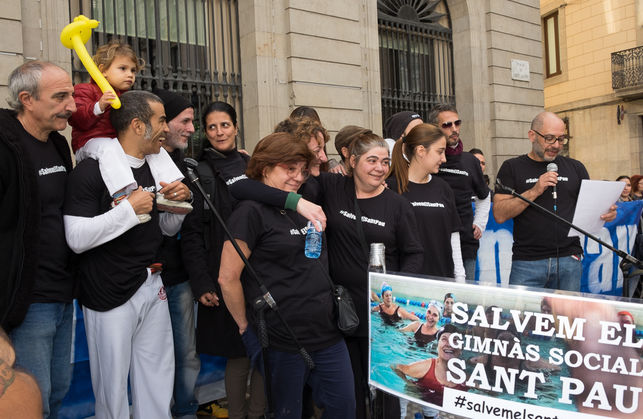
Conflict. In 2016, the workers who owned the gym decided that they could not do more, and closed. Although they had been reducing the debt and losses and getting a good turnover, they continued with an annual deficit of between 15,000 and 20,000 euros and were broken physically and emotionally. They told the City Council to see who and how they were going to take care of all the people they were assisting. The City Council said they could not close and began a negotiation to receive around 8% of the budget as a subsidy. And, although it sounds weird, the problems got worse.
The negotiation was quick and it ended well. The trauma came from the difference between the terms of the administration and those of life itself. Thinking that it would be two or three months and before the pressing economic situation, the gym decided to only pay salaries and consumption and not take charge of the rent. But the deal was extended - finally, there has only been an aid in the form of an agreement for a year - and Sant Pau got into a real mess.
The property finally saw the opportunity to do its business. In full real estate high came the weakness of its tenants forced by the promises and bureaucratic slowness. And then, just when the eviction seemed final, the Salvem el Sant Pau movement was born.
For the first time, the gym workers, instead of giving help, asked for it. First came the powerful cooperative movement from Barcelona, to which they went in search of "mostly emotional" support, but which ended up contributing much more. In fact, the gym went from being SL to being a cooperative. Ferran Aguiló, activist, member of a multitude of cooperative projects (Mon Verd, Germinal, Biciclot, La Borda ...), who is also part of this and one of the first people who came to take an interest in his situation, says: "I saw the situation and suggested that a good strategy to face the challenges, which were not only economic, but also of organization and of moods, could be to join the cooperative movement ".
From that moment, the network of supports multiplied. Around forty groups and entities joined the defense of the gymnasium - a heterogeneous group: from the Escoles Feet to the Islamic Council of Catalonia, through a multitude of Foundations and social services, neighborhood associations and merchants and even prisons - and, also , hundreds of neighbors from the neighborhood and the entire city. There was mobilization in social networks, gatherings in Plaça de Sant Jaume, repercussions in the media, an upheaval that managed to change a result that seemed obvious. And something else.
Not only there was no eviction, but the movement Salvem Sant Pau managed to stop the negotiation for which the property intended, in exchange for letting them continue their activity for a couple of years, build homes on an adjoining lot in the street of Reina Amalia . Finally, it was possible for the City Council to buy that land to make social housing and then guarantee to continue four more years with the gym. But the movement wanted more.
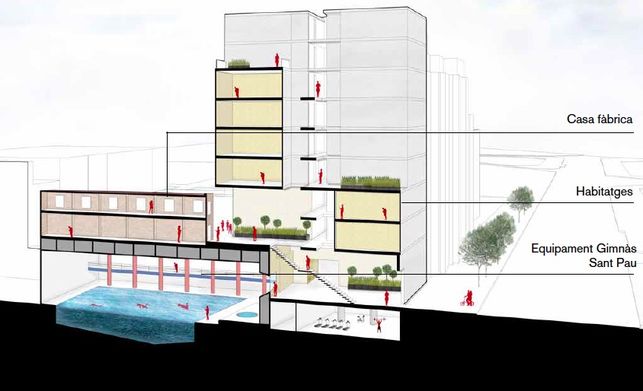
The proposal. Among all the people, collectives and individuals, who had joined the defense of the gym, there was so much mobilization capacity, knowledge and experience and so much desire to think and try other ways of doing city that the Salvem Sant Pau movement ended up becoming Habitem el Sant Pau. A multidisciplinary team made up of architects, town planners, lawyers, economists and activists began to design a proposal that tried to extend the social action of the gym vertically and that could become something like the bright reverse of the commercialization of the district and the city.
I try to summarize what this project proposes: housing is built on the Sant Pau plan, but in a hybrid model between the cooperative, the social and the welfare. Of the 47 houses, twelve are dedicated to people at risk of exclusion (the last one is for a social worker). The rest are cooperative and at the same time public, in an innovative format based on the Anglo-Saxon Community Land Trust - with a management between administrations and neighbors that has been operating for more than forty years in EE places. UU, Canada and United Kingdom-.
But the novelty does not end here and it is also in the form of building, in a model called ATRI (Tactical Groups of Inclusive Repopulation) created by people within the collective and which proposes, among other things, to hire equipment and materials with social criteria, proximity and of sustainability, to apply constructive systems that are faster and more modular and, at the same time, reversible and to finish the work in a participative way and with self-construction techniques as a way not only to lower costs but also to achieve cohesion among the different inhabitants.
"With the ATRI model we could transfer what was happening in some way around the Sant Pau, the social design, the management model, to architectural criteria. In addition, it was a way to build with a minimal affection to the gym activity. " The speaker is David Juarez, founder of the architectural studio Straddle3, member of the participatory construction network Arquitecturas Colectivas and part of the team behind the proposal that structures Habitem el Sant Pau. "What we wanted to demonstrate with the proposal, and with ATRI, is that there are possible methods of developing public or social housing in the consolidated centers of the cities. From an urban angle, looking for urban voids conducive to be complemented with the installation of housing, something we like to call urban dentistry;
For all this to happen, a premise was necessary: land ownership should be public. Habitem Sant Pau began a mobilization aimed at getting the Barcelona City Council to buy the property. On the one hand, the aim was to include the issue in the annual popular multi-consultation instituted by the government of Barcelona en Comú. On the other, bring the issue to the full City Council. For the collection of signatures destined to reach the popular vote, more than 400 people were mobilized in 68 points of the city, apart from the social network fuss, and it was possible to reach the 21,000 demanded although, finally, the proposal did not end up going to voting for a defect in form that the gym considers very strict. But there was still the trump card.
On May 25, 2018, at the proposal of the CUP and with votes in favor of all groups except the abstention of PP and PSOE, the City Council of Barcelona approved the purchase, before December 31, 2018, of the site located on 46, Ronda de Sant Pau -purchase that should be on the part of the City Council itself, the housing consortium or the Generalitat and within the price range established by the consistory-, in respect to the gymnasium and allocate the construction to social housing and do it from the proposed project from Habitem el Sant Pau. A victory that really was not so much.
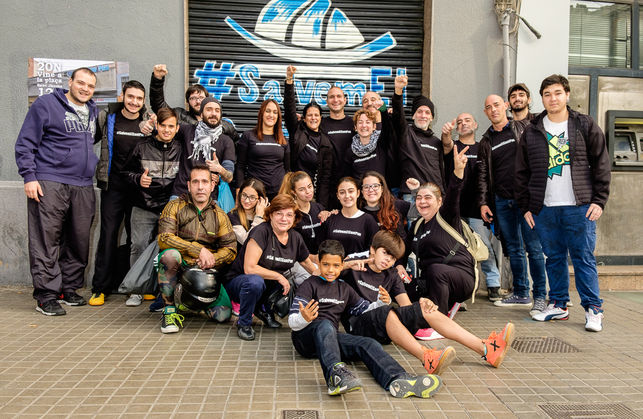
The situation. Today the Sant Pau, the social housing project and the gym itself are in more danger than ever. Less than a month from the end of the year and the commitment of all of this, the City has not moved to exercise the purchase committed on file. The workers' cooperative has been reduced from sixteen to ten, salaries have been reduced by 30% and their working hours have increased to equalize income and expenses and facilitate the agreed solution. It has also sought another way and, in view of the inaction of the consistory: It has contacted potential buyers of the building, a group of companies that would build housing for the free market, but with the commitment to keep the gym open, guarantee their future and the work of the cooperative members and the offer of assistance in other buildings in the city.
The property, in turn, is in a hurry to get out of the middle of the gym and sell. In this time, Barcelona City Council has approved the rule that requires that the new real estate developments dedicate 30% to social housing, but as its application begins in 2019, the market is now hotter than ever. For this reason, the Samaranch-Viñas have again requested eviction for non-payment of three incomes, lack of maintenance and absence of insurance. The trial was held last week and the sentence will come next, and although it looks bad, Sant Pau says it will appeal if it rules against them.
And the City Council, what does it say? The answer is sent from the press department in an email that does not admit much question back and says the following: "This acquisition (the gym) could be carried out if two essential requirements were met: that the Generalitat was involved in the operation and that the property was willing to sell the property at a price that was within the price instruction that has the City of Barcelona for the acquisition of real estate (...). To this day, we maintain contact with both the Gimnàs and the property of the building in which it is located in order to ensure that the project of Gimnàs Sant Pau can pull forward regardless of the formula and without necessarily supposing the purchase of the property by the Consistory,
For what counts those who are close to these negotiations, the City Council will not exercise that purchase option. Some say that the entire budget for this type of acquisitions has already been spent, and some argue that it will not do it because it prefers to focus on broader housing projects that welcome more people. To finish the panorama, the renovated and very close Sant Antoni market has planned the opening of a gym, private and low cost, after a municipal bid.
In the cooperative and its surroundings, in which there are people very much involved in the commons, there are different degrees of despair before the attitude of the City Council. In the case of Ferran Aguiló, there is a monumental and understandable anger expressed as follows: "The only thing we ask is that you withdraw at once, stop making noise, because we can not survive beyond December if not There is a purchase commitment. The City Council is not doing its work from the social point of view, it sends people and does not give us anything. We need you to let us negotiate with the companies that we have got interested in us. If we have to sink, we will sink alone, but do not sink them. "
Sant Pau faces these days to what may be the final fight. The majority of the workers, the only thing they aspire to like Ferrán, is to finish and keep their jobs, they are worth saving the gym through that purchase agreement negotiated by them. Among the support group, there are still those who see the project of social and community construction possible. In any case, taking advantage of the sentence and the countdown, the Sant Pau promises more mobilizations, more pressure.
The moment is key and the question too. The town hall that Ada Colau presides over made a terrible mistake by letting the gym die and not making a last effort to save its innovative proposal. It is true that governments have a special paralysis in pre-electoral periods and that the situation in Barcelona is delicate, but it is assumed that Barcelona in Comú did not appear and was not chosen to behave like any government. As I said at the beginning of the text, Sant Pau and its project show a good part of urban conflicts and propose solutions for them: gentrification, housing emergency, inequality, exclusion, social housing, integration, neighborhood participation, Democracy ... Not understanding it like that and letting the battle be lost would be a disappointment hardly bearable for gym workers and for the people and groups that have been mobilizing in their favor for years. And for the city itself."
Originally published here: https://www.eldiario.es/desde-mi-bici/salvar-gimnasio-salvar-ciudad_132_1804065.html

